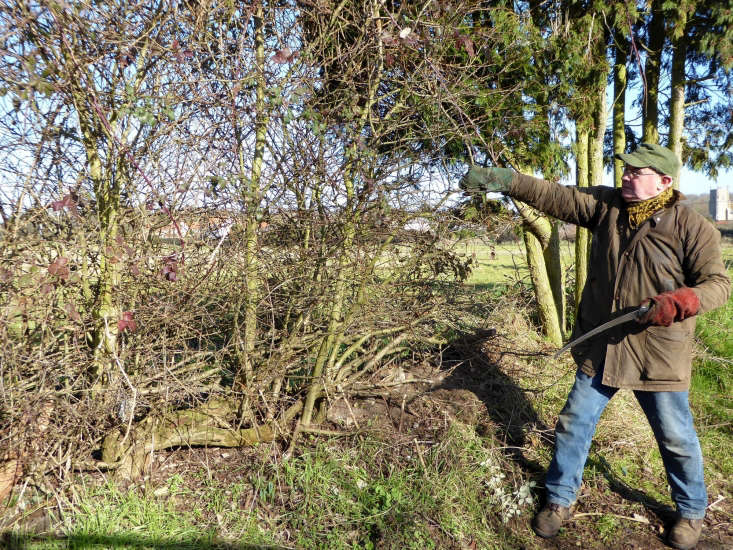To most gardeners, hedge maintenance means a neatening trim with the shears once or twice a year, but there’s a more extreme form of maintenance: hedge laying.
An ancient technique that is as old as hedges themselves (and was referenced by Julius Caesar when he invaded what is now France, two thousand years ago), hedge laying is a radical process. It involves pleaching a plant at the base to force it to regenerate and is still practiced by specialists in the United Kingdom and parts of Europe. And while the technique is largely used in rural areas, the principles can just as easily be applied to domestic gardens, to create stronger, more balanced plants.
Photography by Clare Coulson, except where noted.

Why lay hedges?
Unmaintained hedges can have lots of problems. They can have uneven growth and gaps, be top heavy (a common problem if they haven’t been pruned properly), or cold bottomed or infested with ivy and other undesirables. Hedge laying will regenerate growth from the base of the plant, eventually creating a stronger, more balanced hedge.

How is hedge laying done?
Initially a hedge layer will thin out the hedge, removing any undesirable overgrowth and removing side shoots, to allow light to get to the base of the plant and create a clear structure to then start work on the main stems.
Although styles vary, the basic principle remains the same—each main stem is cut near the base at an angle, leaving a small piece of the stem intact, and the stem (known as a pleacher) is then “laid over.” Although anyone could have a go at hedge laying, this angled cut is quite critical: it needs to be deep enough to allow the hedge to be laid down but it also needs to leave enough bark and sapwood for the hedge to regenerate.

Sap will continue to rise through this small amount of wood, keeping the plant alive. But the cut also will force the plant to regenerate, providing lots of new growth from the base. Each stem is pushed over at the same angle. “Heels” are then cut from the base of the stem to create a clean surface that sheds rainwater (avoiding rot) and to encourage regeneration near ground level.
After all the main stems are laid over, upright stakes are spaced along the hedge and then woven with ‘binders’ (usually hazel), which gives the whole structure strength. It has the added benefit of creating a beautiful living structure too.

What are the tools of the trade?
Like ancient torture weapons, the hedge layer’s armory of tools is basic but effective; billhooks, saws, a mallet, and industrial-strength loppers are all essential pieces of kit. “A sturdy pair of gloves is also a must,” adds Esling, “as is a peaked cap and glasses to keep prickles out of your eyes.”

What kinds of hedges can be laid?
Most hedging can be laid; hawthorn and blackthorn are among the best hedging plants but field maple, hazel, dogwood, Vibernum opulus, spindle, lilac, and elm are all suitable.
A few plants are not suitable; conifers such as Leylandii cypress will not regenerate from old wood, but yew and Western red cedar both respond to laying. And some shrubs are too brittle for this technique, including elder, snowberry, laurel, and hydrangea.
For really overgrown boundaries some hedge layers will work with a tree surgeon to remove bulkier trees first.

When and where is it best to practice hedge laying?
Hedge layers work through the winter when plants are dormant and the tracery of the structure readily visible. Winter also is the time when the materials including the stakes and bindings necessary for hedge laying are readily available and, of course, the best time to plant new hedging if there are gaps to fill. Almost any hedge can be laid, from small relatively young hedging through to very established old boundary hedges.
How much does hedge laying cost?
It depends on the amount of work involved as there’s no such thing as a standard hedge but a very straightforward young hedge (from around seven to 15 years old) would cost about £10 per meter (which includes all the materials).
N.B.: Are you trying to decide what sort of hedge to plant? See our primer at Hardscaping 101: Hedges. And see all our Shrubs plant guides, including:












Have a Question or Comment About This Post?
Join the conversation (0)